
Fictional Architecture of Manhattan
Tribeca
Tribeca is another abbreviated portmanteau word, designating the Triangle Below Canal, the part of the triangular southern extent of Manhattan south of Canal Street not including the Financial District. Residential development began here in the late 1700s. By the mid-1800s it was a commercial center, a center of the textile trade through the early 1900s. The industrial base had mostly disappeared by the 1960s. Many artists moved into the empty commercial spaces throughout the 1970s. Since the 1980s, Tribeca has become a very upscale residential neighborhood. Many actors and other creative types live in the neighborhood.
Doctors Peter Venkman, Raymond Stantz, and Egon Spengler moved their operational headquarters to 10 North Moore Street in Tribeca during the mid 1980s.
This facility, apparently returned more recently to the use of the New York Fire Department, now hosts Hook and Ladder Company #8.
It is located near the Franklin Street subway station.
Alicia Masters' home and studio are also located in Tribeca.
Financial District
The New York Stock Exchange is located at the corner of Wall Street and Broad Street. While its address is 11 Wall Street, the distinctive columned façade seen here faces Broad Street.
Wall Street runs roughly east to west, from the East River to Broadway, much of the way across the narrowing southern tip of Manhattan. Broad is a narrower and less straight street. The Financial District is down in Old New Amsterdam, or Nieuw-Amsterdam as its Dutch founders called it since its founding in 1614. The narrow, winding streets are a legacy of those early years.
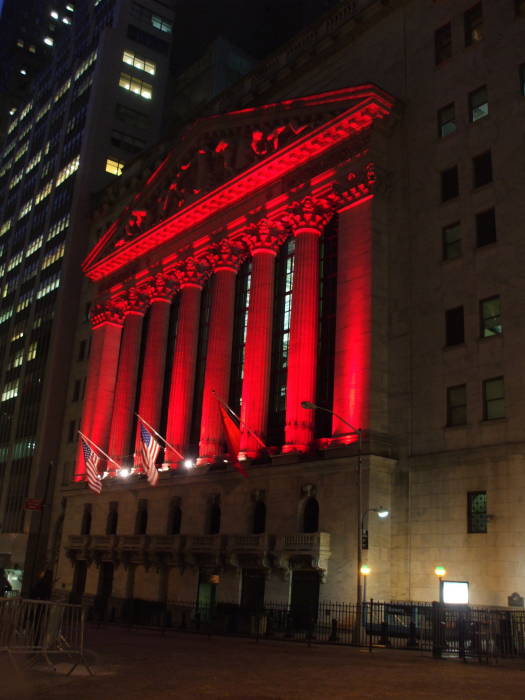
The New York Stock Exchange began with an agreement signed by 24 stockbrokers in 1792. They renamed their organization the "New York Stock and Exchange Board" in 1817. They changed this to the current name, commonly shortened to NYSE, in 1863, and moved to a new headquarters at 10-12 Broad Street in 1865.
Financial growth was rapid in 1896-1901. The volume of stock trades increased by a factor of six during those five years. A new building was opened at 18 Broad Street in 1903.
Wall StreetBombing
At 12:01 on Thursday, September 16, 1920, the Wall Street Bombing occurred. The bomb was 100 pounds of dynamite surrounded with 500 pounds of cast-iron sash weights. It exploded in the back of a horse-drawn wagon across the street from the J.P. Morgan bank at 23 Wall Street. 38 people died, most of them within moments, and many more suffered severe injuries. It was the deadliest terrorist act on U.S. soil up to that date.
Without a clear link to any group, the bombing was initially thought to have possibly been some sort of an accident. An investigation by the NYPD and the U.S. Justice Department's Bureau of Investigation looked into anarchist and communist groups after the discovery of anarchist flyers was announced the following day. The governmental investigation continued for three years without success. Nick Charles was later involved in the investigation through his work for a private detective agency.
This additional new building seen here was opened at 11 Wall Street in 1922, housing a mixture of offices and a large trading floor. Other trading floor space was added in 1969 and 1988, and another trading floor in another location at 30 Broad Street in 2000.
The NYSE merged with the fully electronic exchange Euronext in 2007. The entire trading operation now runs on Linux servers. With the rapid move to electronic trading, the 30 Broad Street trading floor was closed in 2006. The trading rooms created in 1969 and 1988 were closed in 2007.
Auric Goldfinger concocted a mad scheme to detonate an atomic bomb at the U.S. Bullion Depository in Fort Knox, irradiating the gold store there and rendering it useless and thus worthless for decades. This would have caused world-wide economic chaos and increased the value of his own gold.
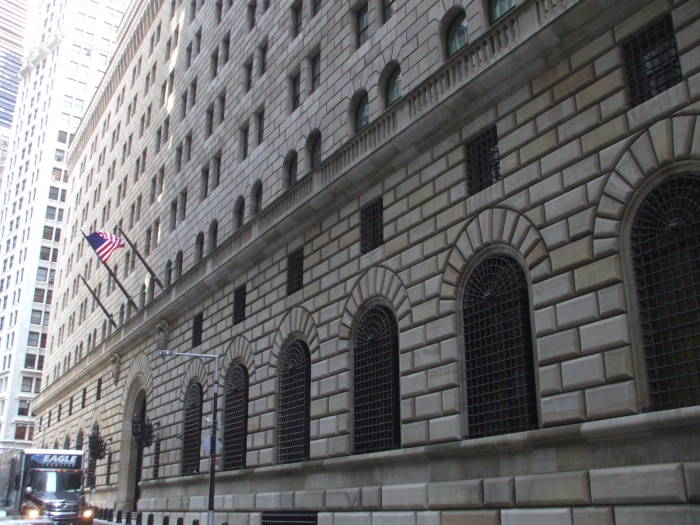
While a development economist at the World Bank thought this scheme was plausible, other analysts found economic problems with it.
Also, 195Au is the only isotope of gold with a half-life longer than a few days (186 days) and as a radiation safety officer explained, that isotope is impossible to create through neutron irradiation.
Simon Gruber, the brother of Hans, realized that Goldfinger selected the wrong target. Fort Knox holds 4,578 metric tons of gold while the Federal Reserve Bank of New York at 33 Liberty Street has 7,000 metric tons.
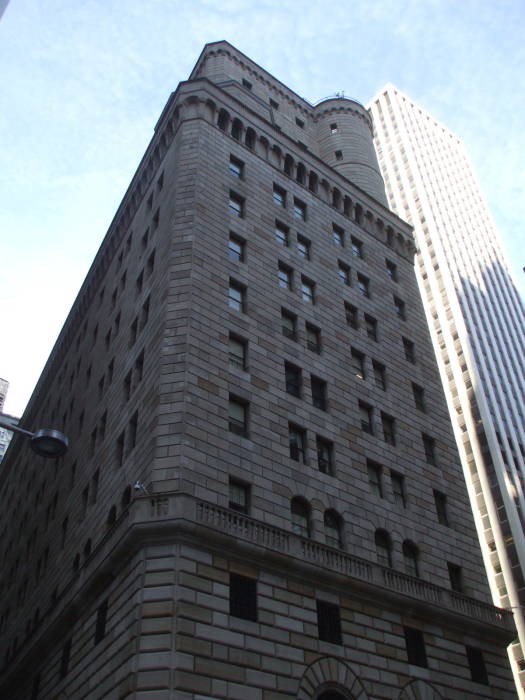
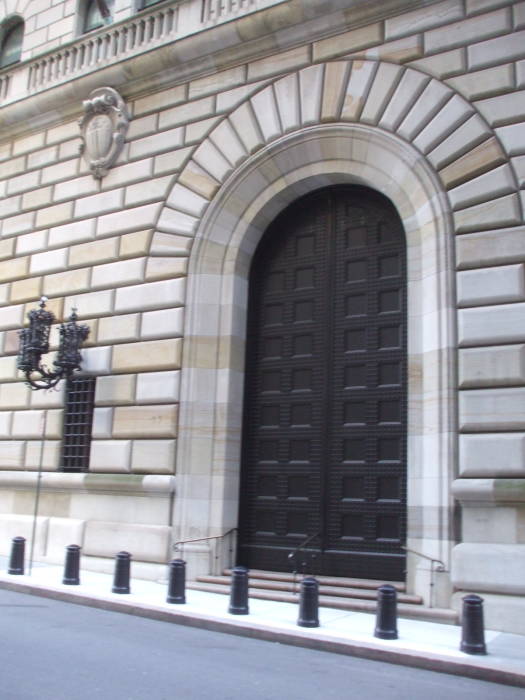
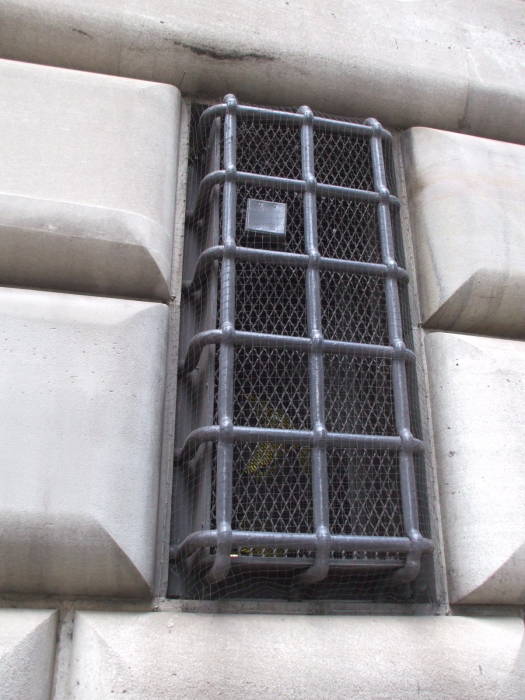
By 1927, 10% of the world's official gold reserves were stored here. It is now thought to be the largest gold repository in the world with 25% of the world's existing gold reserves, although Swiss banks do not report their gold stocks and so this cannot be verified. Almost 98% of the gold stored here is owned by the central banks of 36 foreign nations. The Federal Reserve Bank does not own the gold or charge for its protected storage, but it does charge a per-bar fee for moving the gold to transfer it between owner nations.
The building fills the small irregularly shaped block and looks like the fortress that it is. The vault rests on bedrock 80 feet (or 24 meters) below street level and 50 feet (or 15 meters) below sea level. You can't get into the vault from the subway system, so John MacClane and Zeus Carver didn't really need to go to all that trouble.
The Downtown Manhattan Heliport is at Pier 6 in the East River, just a few blocks south of the east end of Wall Street. Gordon Gecko and other high rollers could use it to commute to the Financial District. Here we see the heliport from above, from Thomas Crown's office. Beyond the heliport, across the East River, is Brooklyn.
The ICAO designator for the heliport is KJRB. It's at 40.7011°N 74.0088°W, just 2 m AMSL. Normal hours of operation are 0700-2200 Monday-Friday, 0900-1900 Saturday, 0900-1700 Sunday. Common traffic advisory frequency is 123.05 MHz.
Marine One, the U.S.M.C. helicopter carrying the President of the United States, usually uses this heliport for Presidential visits to New York. The aircraft is either a VH-3D Sea King or a VH-60N WhiteHawk operated by the HMX-1 Nighthawks squadron, based at Quantico, Virginia.
Moving to the south side of Crown's suite taking up the entire 31st floor, we can look out over New York Harbor. The Staten Island Ferry terminal is partially visible at lower left. Governor's Island is partially visible at left.
On the horizon, Staten Island is visible in the left half, and the Port of New Jersey in the right half. In front of the port area is the Statue of Liberty.
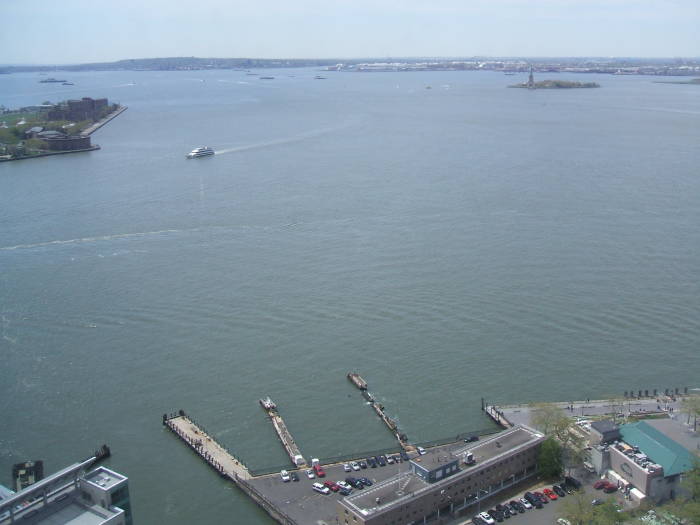
India House, on the corner of Hanover Square and Pearl Street, was built in 1851. The New York Cotton Exchange was founded here in 1870, the second such exchange in the world and the first commodity market in the U.S. In 1914, it became the India House private club. The building now houses restaurants, including the very swanky Harry's café and steakhouse where Patrick Bateman has frequently dined at Harry's with his girlfriend Evelyn Richards and his best friends and colleagues Timothy Price, Craig McDermott, and David Van Patten, as has Sherman McCoy, Gordon Gecko, and other Masters of the Universe.
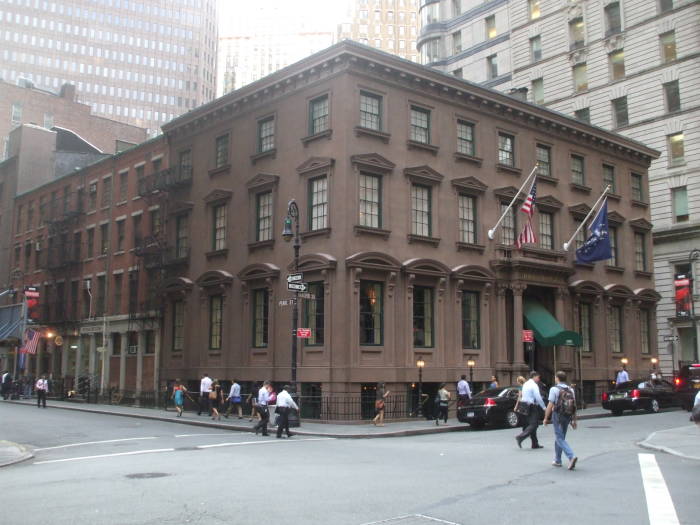
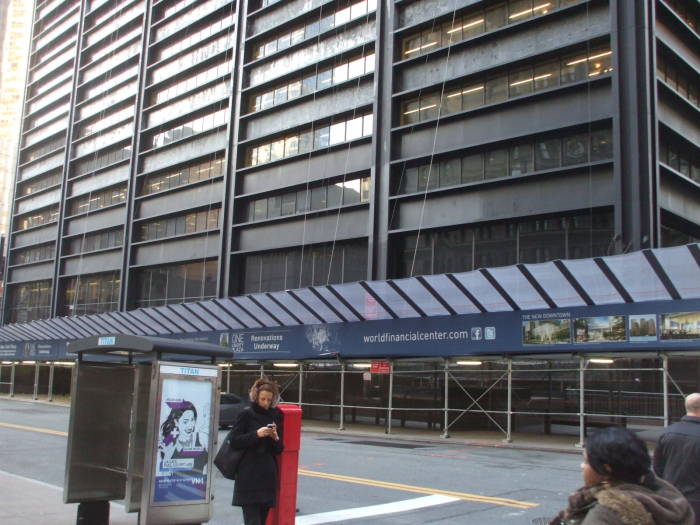
Nikola Tesla had a laboratory at 89 Liberty Street in 1887. But very little of that era survives in lower Manhattan. His lab's location is now in the base of a tall office building.
The National September 11 Memorial and Museum is at the former site of the World Trade Center towers. That's in the open space just ahead of us, at the end of the block in the first picture below.
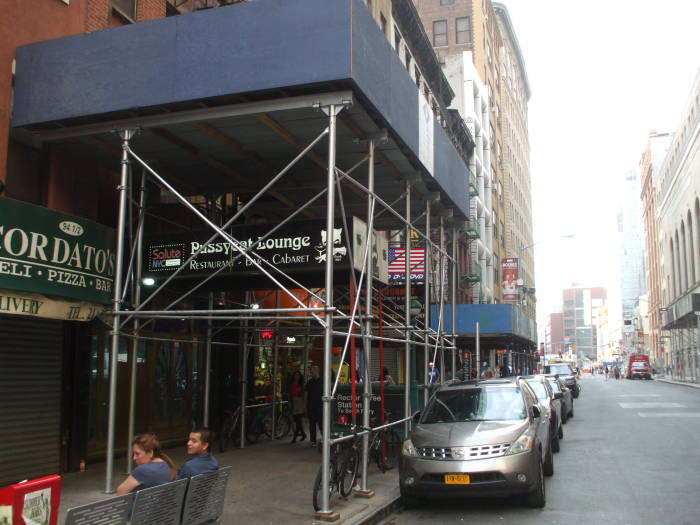
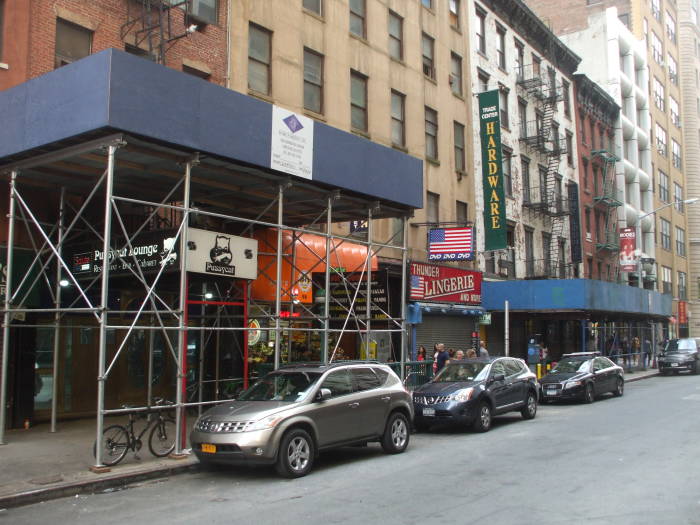
The Pussycat Lounge and Thunder Lingerie are a block away from the memorial. The proposed Park51 Islamic community center that caused so much controversy is about twice as far away from the memorial. Apparently the Right Wing has no problem with grimy strip clubs and porn shops.
The New York Police Department headquarters is near the end of the Brooklyn Bridge, behind City Hall and close to the cluster of court buildings.
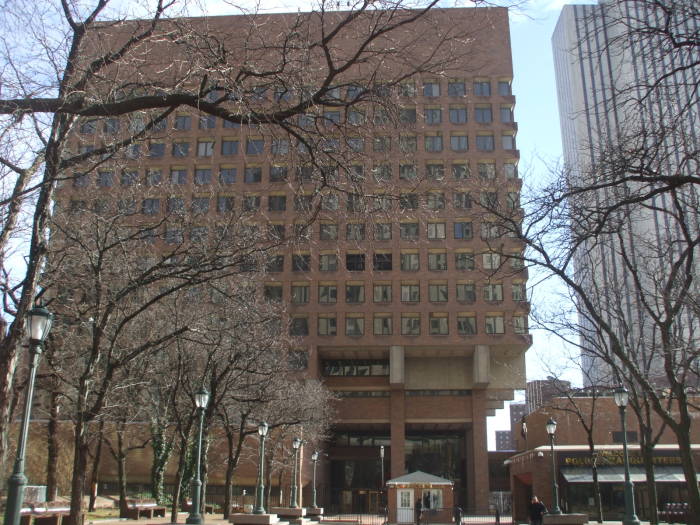
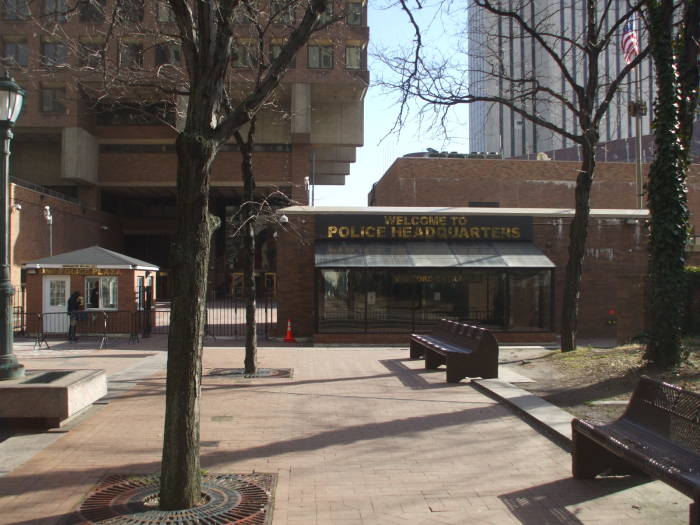
Mike Hammer frequently visited his buddy Pat Chambers, a Captain of Homicide, in his office at headquarters.
We're on the relatively new viewing platform at the South Street Seaport, visited daily by military virologist Robert Neville.
We are looking north, up the East River. The closest bridge is the Brooklyn Bridge. Beyond that is the Manhattan Bridge, and the Williamsburg Bridge is visible further in the distance.
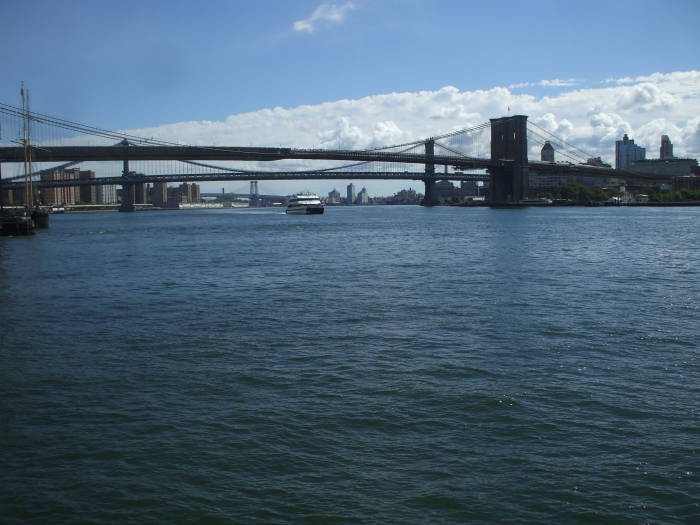
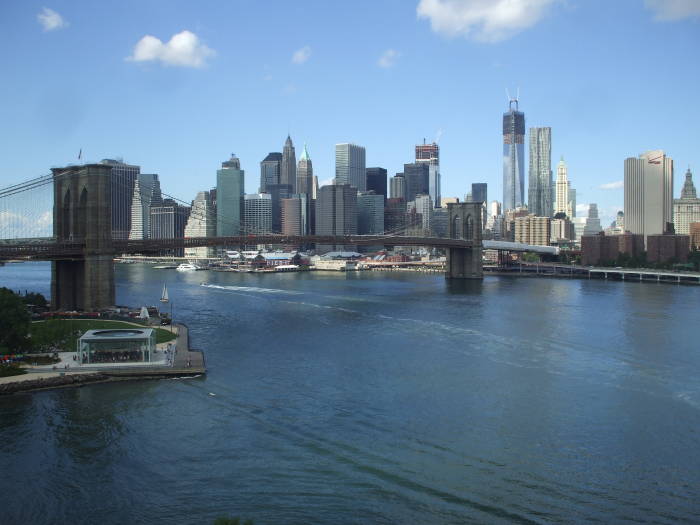
All the bridges across the East River have pedestrian walkways with spectacular views.
The Brooklyn Bridge, seen here from the south-side pedestrian walkway of the Manhattan Bridge, was completed in 1883. Its main span between the towers is 1595.5 feet long, but it is 5,989 feet long in total. There are three vehicular lanes in each direction, with a raised central bicycle and pedestrian walkway.
The anchorage at the Manhattan end contained a Cold War bunker, inside one of the arched masonry structures under the western main entrance ramp. It was re-discovered by city workers in 2006, at which time it still contained emergency supplies stored in case of a nuclear attack by the Soviet Union. According to the National Geographic article, the supplies included water containers and medical supplies. There were blankets marked "For Use Only After Enemy Attack" and 352,000 cookies sealed in tin cans marked "Civil Defense All Purpose Survival Crackers".
The Manhattan Bridge opened in 1909. Its upper level has two vehicular traffic lanes in each direction. The lower level has three vehicular traffic lanes, two subway tracks on each side of those (N and Q trains on the south pair, B and D on the north pair), and a bicycle and pedestrian walkway along each exterior edge. You have to commit to a southerly view (as here) or a northerly view before starting across on foot.
Its main span between the towers is 1,470 feet long, with a total length of 6,855 feet.
The Williamsburg Bridge opened in 1903. It has eight lanes of roadway and two tracks of the J, M, Z trains, plus pedestrian and bicycle pathways on the exterior.
Its main span between the towers is 1,600 feet long, with a total length of 7,308 feet. It crosses the East River significantly further to the north. The Brooklyn ends of the Brooklyn and Manhattan Bridges are just a few blocks apart.
Back to International Travel

